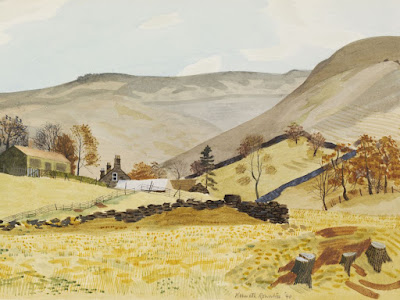In December 1939, three months into the war, Kenneth Clark, then Director of the National Gallery, had a brilliant idea: to send artists out to all corners of the land to create 'a pictorial Domesday of pre-war Britain' – a Britain that might soon be lost, either to German invasion or simply to the march of 'progress'. Clark approached the American-backed Pilgrim Trust and the Ministry of Labour, and proposed a scheme that would keep needy artists employed and, he hoped, 'save the whole tradition of English art'. His visionary scheme, now called Recording Britain, was soon under way, and by 1943 some 1,500 topographical watercolours had been produced by more than 60 artists, including John Piper, William Russell Flint, S.R. (Stanley) Badmin, Barbara Jones – and Kenneth Rowntree, whose name has been popping up in my corner of Facebook lately.
Rowntree, a friend of the now more famous Eric Ravilious and Edward Bawden, and for a while one of the Great Bardfield artists, was a talented and versatile painter who worked in several styles – never a good idea if you've got an eye on posterity. As an accomplished watercolorist, he was a natural for the Recording Britain project, and Rowntree was soon in action, responding to a request from Derbyshire county council – the only one in England to put in a plea for a specific record to be made in its county. The Derwent Valley Water Board was going to build a third dam in the upper valley, which would create the massive Ladybower Reservoir – and, in the process, drown a large area of land, including the villages of Ashopton and Derwent and several farms. Rowntree's commission was to paint whatever caught his eye before it disappeared under the waters. The result was at once a charming set of watercolours and a poignant record of a small world about to be lost...
This is the Smoke Room (ah, those were the days) of the Ashopton Inn, the kind of plain unspoilt pub interior that was once standard but is now harder to find, even in Derbyshire –
And here are two of the farms that would soon be submerged: Grainfoot Farm in Derwentdale –
And Underbanks Farm in Woodlands Valley, under a hillside already scarred by the deep furrows in which the Water Board would plant regiments of Sitka Spruce –
Here is a view in Ashopton village, showing the old toll bar house –
And here is the Wesleyan Methodist Chapel, built in 1840. The final service was held there on 25 September, 1939, and the last hymn sung was 'The Day Is Dying in the West'...






Ladybower is where the Dambusters trained for their raids on the Ruhr. Not that far from my childhood home of Sheffield.
ReplyDeleteThanks Simon – quite so.
ReplyDelete